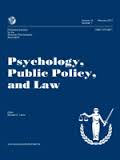 The following study identifies a functional link between perceptions of social structure, endorsing criminal stereotypes, and supporting harsh criminal justice policies. This is the bottom line of a recently published article in Psychology, Public Policy, and Law. Below is a summary of the research and findings as well as a translation of this research into practice.
The following study identifies a functional link between perceptions of social structure, endorsing criminal stereotypes, and supporting harsh criminal justice policies. This is the bottom line of a recently published article in Psychology, Public Policy, and Law. Below is a summary of the research and findings as well as a translation of this research into practice.

Featured Article | Psychology, Public Policy, and Law | 2016, Vol. 22, No. 1, 46-57
The Functional Relation Between Social Inequality, Criminal Stereotypes, and Public Attitudes Toward Punishment of Crime
Authors
Carolyn Côté-Lussier, London School of Economics and Political Science
Abstract
The public’s “appetite” for punishment of crime has led some to compare support for harsh criminal justice policies to a practice of excess, much like craving ice cream. But what drives this appetite for punishment? This study investigates the functional relation between social structural factors of competition and social status, the endorsement of criminal stereotypes, and affective, behavioral and punitive responses to criminals. Results suggest, first, that perceiving criminals as competing against society for resources and power and as having a low social status (e.g., in terms of economic and educational attainment) is associated with perceiving criminals as being cold and untrustworthy, but somewhat competent and efficient. These perceptions are associated with feeling more anger and uneasiness, and less compassion toward criminals. Finally, feeling angry toward criminals is associated with supporting harsh criminal justice policies (e.g., giving law breakers stiffer sentences). The findings suggest that perceptions related to increasing social inequality could engender shifts in the endorsement of criminal stereotypes that are associated with public punitiveness.
Keywords
punitiveness, stereotype content model, United Kingdom, structural equation modeling
Summary of the Research
“While punishment of crime is, for all intents and purposes, qualitatively milder than it was only a few hundred years ago, the latter half of the 20th and beginning of the 21st century has seen the introduction of increasingly harsh criminal justice policies in countries such as the United States, Canada, and the United Kingdom. This punitive trend is evidenced most visibly in growing prison populations: In the United States, the prison population has risen sixfold in a quarter of a century … Some evidence suggests that this long-term increase in punitiveness is partly the result of public attitudes that supported and pushed for harsher criminal justice policies” (p. 46).
“The hypothesis that increasing crime rates are driving public punitiveness is only partly supported. First, crime rates have been decreasing in much of the western world for the past 20 years. Second, although some evidence suggests an association between the crime rate and public punitiveness, this association appears to be modest at best. Alternatively, it is possible that the public demand for more punitiveness is due to a perceived failing of the courts to be sufficiently punitive. But the evidence in favor of this hypothesis is also weak” (p. 46).
“An additional hypothesis could be that public punitiveness reflects individuals’ emotional responses to crime. Punitiveness is associated with strong negative affective responses to crime, such as anger, and experiencing fewer positive emotions toward criminals, such as sympathy. But what could be contributing to sustained strong negative emotional responses and punitiveness toward crime? One hypothesis is that affective responses to crime are associated with criminal stereotypes or the increased salience of these stereotypes. The endorsement of specific criminal stereotypes has been linked to increased negative emotional and punitive responses toward criminals” (p. 46-47).
“Endorsing stereotypes about criminals more broadly (e.g., about their evil and callous nature) is also associated with making more punitive decisions and expressing more punitive attitudes. For example, believing that “most criminals commit crimes because they are basically selfish people, unconcerned
about the feelings of other people” is associated with endorsing statements such as “criminals should be punished to make the criminals suffer, as the victims of the crimes suffered.” However, research has yet to provide a theoretical framework linking the endorsement of criminal stereotypes to functional emotional responses (i.e., affective responses systematically linked to specific behavioral responses) that engender punitiveness, a type of aggressive behavioral response” (p. 47). “According to the stereotype content model (SCM) and behavior from intergroup
affect and stereotypes (BIAS) map, social perceptions of others generate appraisals and interpersonal comparisons that engender corresponding changes in emotional responses that motivate functionally related social behaviors. These perceptions, which form the content of social stereotypes, reflect two fundamental dimensions: perceived warmth (i.e., kind, trustworthy, understanding) and perceived competence (i.e., intelligent, efficient, skillful)” (p. 47).
Translating Research into Practice
“This research addresses an important gap in the literature by testing the central hypothesis that variance in the endorsement of criminal stereotypes is associated with variation in corresponding emotional, behavioral, and punitive responses. Though the study does not investigate longitudinal changes in perceptions and responses to crime, it aims to provide compelling evidence of a functional relation between perceiving criminals in stereotypical ways and supporting more punitive responses to law breakers” (p. 48).
“Participants (N = 172) were London (U.K.) university students who filled out a survey at a booth (in 2009–2010) located on campus for the chance to win one of several cash prizes… Participants first completed a section on more general criminal stereotypes before completing the SCM and BIAS map measures, and lastly answered questions about themselves” (p. 49).
Results
“In absolute terms, criminals were perceived as being somewhat competitive but as having a considerably low social status. Criminals were perceived as being low on dimensions of warmth and competence in absolute terms, but were perceived as being significantly more competent than warm. On average, criminals were most likely to elicit negative emotions such as anger and fearfulness, and least likely to elicit positive emotions such as security or fondness. Criminals were most likely to elicit behaviors such as excluding and demeaning, and least likely to elicit protecting and associating behaviors. Correlational analyses suggested moderate correlations between emotional responses and between behavioral types” (p. 51).
“With respect to the social structural determinants of criminal stereotypes, perceiving criminals as being more competitive was expectedly associated with perceiving criminals as lacking warmth. In contrast, perceiving criminals as having a higher social status was associated with perceiving criminals as demonstrating more competence, but also as being warmer” (p. 51).
“Variation in criminals’ perceived warmth and competence was associated with different affective responses. Emotions of uneasiness were associated with perceiving criminals as being less warm and more competent. Similarly, emotions of anger were associated with perceiving criminals as being less warm, and marginally associated with increased perceived competence. The emotion of envy was strongly associated with perceiving criminals as being more competent. In contrast, compassion, the only positive emotional response, was strongly associated with perceiving criminals as being warmer. Attacking behavior was positively associated with emotions of anger, but not with the weaker emotions of uneasiness or envy. Excluding behavior was positively associated with emotions of uneasiness and anger. Both positive behavioral responses, helping and associating, were positively associated with emotions of compassion but not with envy” (p. 51).
“Though all perceptions and response types were allowed to predict punitiveness, punitive attitudes were only directly associated with feeling more anger and showing less desires to exclude criminals. There were significant indirect associations between punitiveness and the social structural determinants and content of criminal stereotypes” (p. 51).
Other Interesting Tidbits for Researchers and Clinicians
“The results also suggest that desires to exclude criminals, a behavioral response that is associated with experiencing uneasiness or fearfulness, is associated with expressing less support for harsh criminal justice policies. Previous research demonstrates that being fearful of crime—a type of diffuse anxious or uneasy emotional response—is associated with increased punitive attitudes. However, the present findings suggest that when considering anger and uneasiness in tandem, it is the former that most strongly predicts punitiveness. These findings suggest that in considering affective responses to criminals, there is a distinction between feeling uneasy and angry toward criminals. Though both emotions are predicted by stereotypes about criminals’ lack of warmth, uneasiness predicts a desire to exclude and demean criminals, while anger predicts a desire to exclude and demean, as well as fight, attack, and punish criminals. The findings may suggest that individuals draw a clear distinction between punishing and excluding criminals. In other words, while individuals who feel uneasy (and, to a lesser extent, angry) toward criminals may want to exclude criminals they do not want to punish them harshly” (p. 53).
“[T]he correlational nature of the study precludes making causal claims about the directionality of the observed associations. To the extent that emotion influences cognition, the directionality of the social perception [to] affect association could be reversed, such that angry emotional responses to crime also influence the endorsement of criminal stereotypes. Indeed, some evidence suggests that perceptions of injustice can engender anger, which, in turn, leads to aggressive behavior and blaming cognitions. The directionality of the social perception [to] affect association should therefore be tested experimentally in future research.
Join the Discussion
As always, please join the discussion below if you have thoughts or comments to add!






















